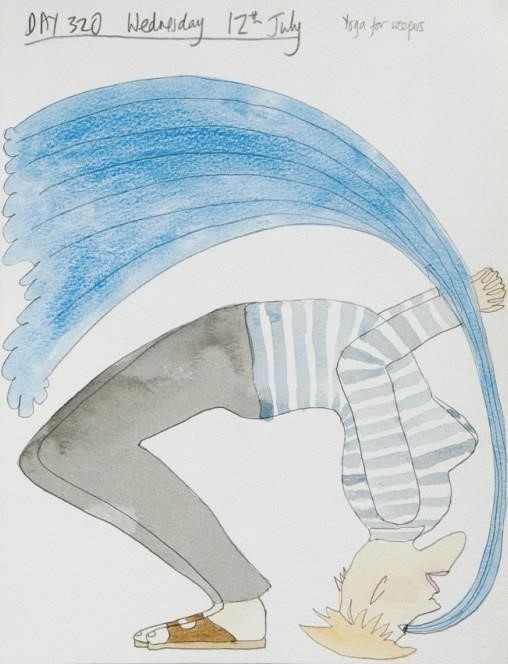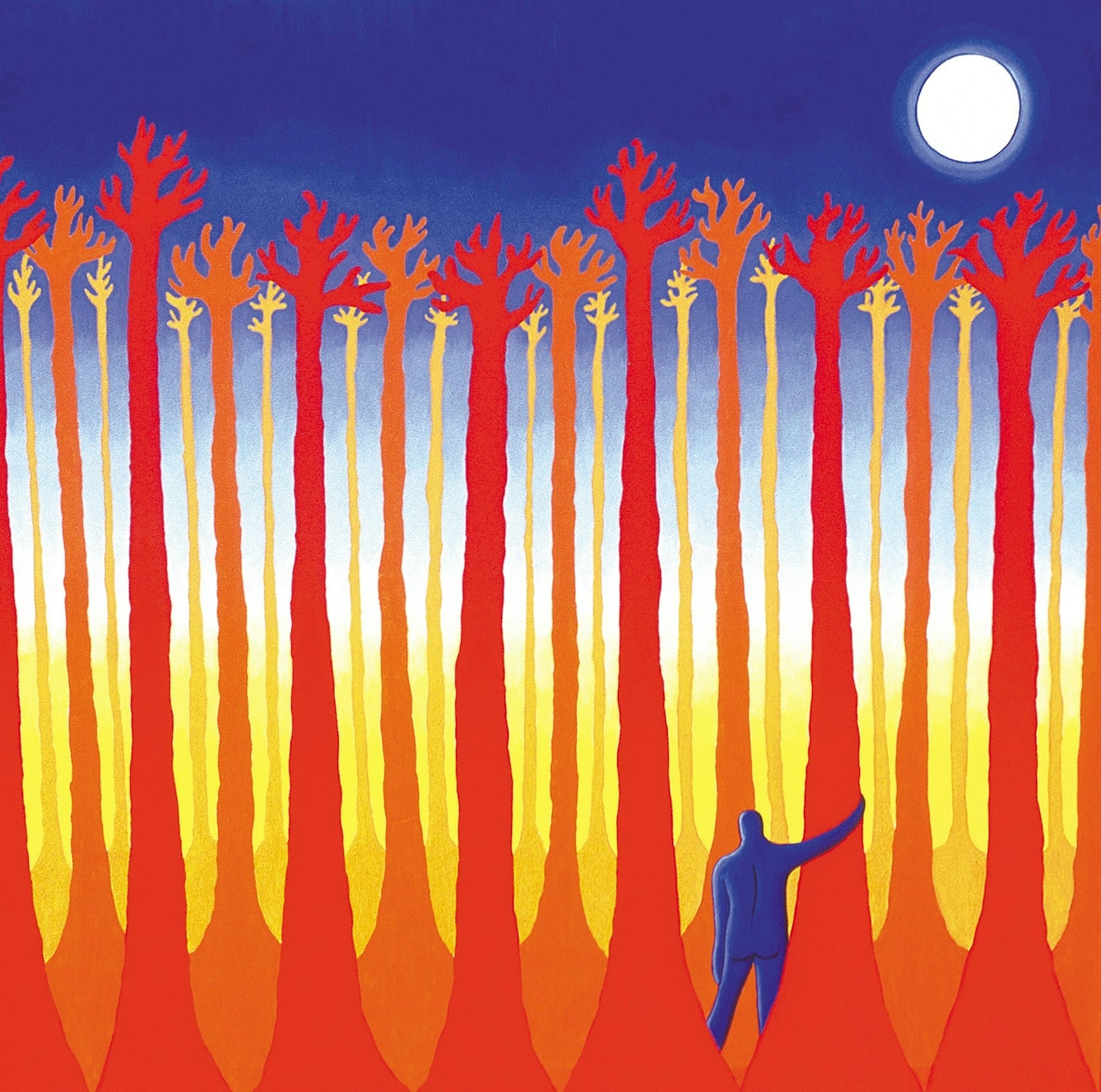For 19th-century psychiatrists the new art of photography was a useful tool, as it allowed them to capture patients’ images and categorise their illnesses into ‘types’. Facial expressions and even clothing were seen as revealing important medical information. But art by people with mental health problems exposes a subtler, more nuanced view of illness, as Leah Sidi explains.
Examining the physical appearance of a patient has been central to psychiatry since its inception, as doctors believed this could reveal important information about the patient’s inner state of mind. During the 19th century, as the asylum population increased, doctors and asylum wardens attempted to divide experiences of mental illness, which they described as ‘insanity’, into rudimentary ‘types’.
With the advent of photography, the practice of photographing asylum inmates and using facial expressions to classify different forms of mental illness became increasingly common.
Seven types of insanity
This image shows seven ‘Types of Insanity’, reproducing photographs taken in the Devon County Asylum in 1858. The features indicating the ‘type’ of insanity vary: the woman at the top looks up with her mouth hanging open, implying that she is vacant, whereas the woman in the middle looks thoughtful and inquisitive, perhaps implying overthinking and mania.
The way in which inmates dressed was also seen to reflect their mental states: here we see some who are well turned out, in middle-class attire, while others are dressed more shabbily.
We might think of this practice of scrutinising appearance in order to deduce and categorise illness as the “psychiatric gaze”.

Seven vignettes of people suffering from different types of mental illness. Lithograph by W Spread and J Reed, 1858.
How the patient sees the doctor
How is the psychiatric gaze experienced by patients? What happens when patients turn this gaze outwards, in order to express what mental illness means for them?
In the etching below by Vincent van Gogh, the artist reverses the psychiatric gaze by drawing a portrait of his friend, the maverick doctor Paul-Ferdinand Gachet. In the background we see the curved strokes typical of van Gogh’s evocative, organic approach to foliage. This contrasts with the stark, straight lines that shade Gachet’s jacket.
However Gachet’s eyes and hands reflect the wobbly, disordered quality of the background. Perhaps we are viewing the artist’s judgement of the doctor’s supposed wellness. Or perhaps the artist’s own distress about being viewed through the psychiatric gaze is being reflected in the face of the sitter.

‘Paul-Ferdinand Gachet’, etching by Vincent van Gogh, 1890.
A study in scarlet
Reversing the psychiatric gaze can mean taking control of one’s own image and embracing ambiguity over rigid diagnosis.
In ‘An anguished figure in a red aureole, holding a curved knife’, Mary Bishop takes a figurative approach to expressing pain. The figure in the image is thin and shrunken, while the red paint, symbolic of the figure’s pain, expands across the paper.
This image is part of the Adamson Collection, a large archive made up of paintings and drawings by patients at Netherne Mental Hospital from 1946–81. The patients were given access to an art studio supervised by artist Edward Adamson. When they were in the studio they were treated as artists rather than psychiatric patients, and could express themselves outside of the confines of the institutional life of the asylum.

‘An anguished figure in a red aureole, holding a curved knife‘. Watercolour by M Bishop, 1967.
Yoga and tears
Artists have expressed their relationships with mental pain and treatment in any number of creative ways. Often images extend beyond the body, suggesting a relationship between mental suffering and the wider environment.
Bobby Baker’s ‘Diary Drawings: Mental Illness and Me’ brings together a collection of drawings from an 11-year stretch during which she experienced a range of treatments within the mental health system following a diagnosis of borderline personality disorder. Baker found this contested psychiatric label to be surrounded with stigma and sexism.
In this image, Baker draws herself attending yoga class at a day centre while experiencing an inability to stop crying. In the image the tears leap from her eyes as she performs a bridge pose, and arc over her body.
This witty observation is at once funny and poignant. Even in her yoga pose, Baker is still enveloped in tears. The image suggests that being an active, ‘compliant’ patient does not free one from the symptoms of mental suffering.

Bobby Baker, ‘Image 320: Yoga for Weepers’, in ‘Diary Drawings: Mental Illness and Me’ (London, Profile Books, in association with Wellcome Collection, 2010).
Which path to follow?
Emotional and physical wellbeing are often interlinked, meaning the psychiatric and the medical gaze are difficult to separate. In his series ‘Emotional Cancer Journey’, Michele Angelo Petrone drew his viewers’ gaze to the emotional and mental toll of his experience of Hodgkin lymphoma.
In this painting, ‘The Maze of Trees’, Petrone depicted illness as a confusing mental and emotional journey. The blue man in the middle of the image grips a tree and contemplates a dense forest in front of him.
Petrone emphasised the role of this painting in expressing his mental state during relapse. “I’m confused. I’m lost as to which way to turn – who to turn to,” he commented. “Before, everything seemed so clear. Now, which way to turn, which path to follow? Help me, please somebody show me the way.”

‘The Maze of Trees’ from ‘Emotional Cancer Journey’, Michele Angelo Petrone.
The endless stairwell
Sociologist and mental health researcher Juliet Foster has noted that we often use the metaphor of a journey to understand and describe experiences of mental illness. Phrases noting the beginning of mental illness, the road to recovery, and the idea of health as a destination are common.
The visual artists I’ve chosen to show here might make us think twice about this metaphor. Like Perone, photographer Neil Tinning depicts his experience of mental distress through an image of a space. ‘Up and Down Mood Disorders’ shows a spiralling metal stairwell. The image is confusing. Initially it might be unclear if we are looking up or down the stairs and whether the seemingly never-ending stairs are real or the result of layered images.
Tinning and Perone both use images of spaces to represent mental distress as an ongoing experience. The idea of moving through the trees of a forest or up and down an everlasting stairwell convey the impression of directionless movement. This might give the viewer an insight into the experience of living with unresolved mental distress or a chronic mood disorder.

‘Up and Down Mood Disorders’, Neil Tinning.
A corridor transformed
Artists have reversed the psychiatric gaze in a number of ways in order to communicate what it is like to live with mental distress. In this image the reversal comes full circle with an art installation transforming a mental health unit.
As part of the King’s Fund’s Enhancing the Healing Environments (EHE) programme, designer Hedley Finn worked alongside service users and patients to redesign treatment spaces. In this instance, the corridor of a mental health unit has been repainted and is now hung with a colourful installation made of individual plastic cones, the colours changing as you walk from one end to the other.
The space is no longer purely functional. It has been transformed into somewhere that can also be looked at and enjoyed. The aim of Finn and the EHE programme was to humanise medical spaces. By creating this installation with patients, Finn generated an environment that does not reduce patients to their psychiatric illness, but acknowledges them as full, creative human beings.

Corridor, Mental Health Unit, NHS Trust, UK. Hedley Finn, The King’s Fund, Wellcome Collection.
Across all of these artworks then, the psychiatric gaze is challenged. These artists not only represent their own experiences but also reveal the importance of the ways doctors see their patients, and the ways those patients see themselves. By creating images for themselves, these artists look back at their treatment and their experiences. In doing so they reveal the breadth, variety and complexity of their mental distress.
About the author
Leah Sidi
Leah is an associate lecturer in Contemporary Literature at Birkbeck, University of London. Her research examines representations of mental illness and community care in contemporary feminist theatre and life writing. Her research has been published in Performance Research and in an upcoming collection of essays in Routledge's ‘Beyond the Couch’ series.

